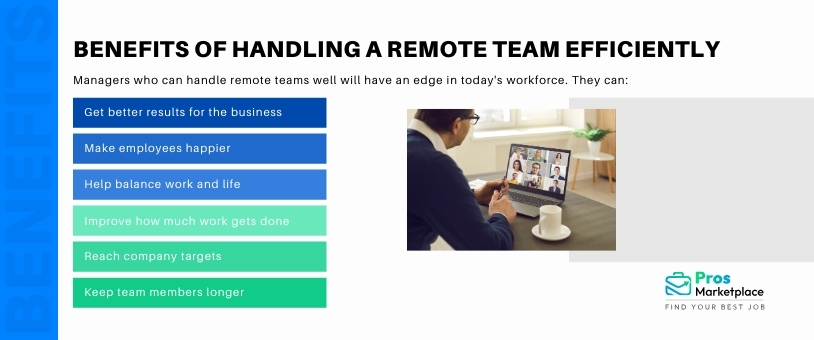Although the future is unpredictable, it is never too late to learn to grab the potential opportunities. After the pandemic, more people are now working from home, and the demand for remote work continues to grow.
However, questions remain. Will the number of remote workers increase or decrease in the future? To what extent will employees prefer remote work? Managers need to step up to effectively handle mobile teams, which brings us to our central question:
Why is Managing a Remote Team Difficult?
There is a lack of personal interaction when working remotely, making managing the remote hard. Team leaders must ensure the unity and satisfaction of the team, even though they are not in the same physical location.
Technology has opened doors, but it’s only half of the solution. Both good leadership and team spirit are crucial. Managers should communicate openly, know their team, and adapt to changes.
The process of coordinating a team spread across different locations can be challenging. Here’s why
Confusion
A remote work environment can leave employees uncertain about their roles and priorities. Without the immediate guidance and face-to-face interaction of a traditional workplace, remote workers may have a hard time deciding exactly what you expect from them.
To avoid this, clarify tasks, goals, and deadlines, such as writing, and check in regularly to provide feedback and clarification.
Additionally, using project management tools and shared information can help keep everyone on the same page and reduce confusion.
Different ways of working
Remote teams often consist of people with different jobs and interests. Some people may prefer a set schedule, while others may prefer the convenience of breaking away from daily routines.
Recognizing and adapting to these differences is critical to improving productivity and health.
Encouraging open communication about preferred work hours and establishing clear expectations for availability and work can help create a work environment where everyone feels comfortable, indebted, and honored.
Communication
Good communication is the foundation of remote working, but communication can be difficult when team members have different communication skills. Some workers prefer communication through email or instant messaging, while others may find a phone call or telephone conversation more suitable for discussion and problem resolution.
To bridge communication gaps, clear processes must be established based on the needs of the group. This may include scheduling regular check-ins, adjusting response times, and using a variety of communication tools to accommodate different preferences.
Loneliness
One of the most common problems of remote working is that employees feel isolated and disconnected from their employees. Without daily communication and companionship at work, remote workers can experience stress and conflict.
To avoid this, organizations can encourage collaboration and community for regular communication and improving relationships among team members.
This may include virtual team building, remote team meetings, and opportunities to collaborate on projects. Encouraging open communication about loneliness and providing support and mental health services can also help remote workers feel connected and supported.

7 Ways to Manage Your Remote Team
With remote work becoming increasingly common, many managers find themselves handling teams from a distance. However, managing remote teams isn’t always easy; it demands time, knowledge, and practice to master. Although managing remote workers has its challenges, we’re here to assist you in becoming an expert remote manager. Let’s begin by discussing some tips for working from home and effective strategies.
Make sure everyone is on the same page
During your regular conference calls, discuss how people feel technology is either helping or hindering their work. Encourage them to share the tools and features they use to stay productive and connected. Ensure everyone understands how these systems work, why they’re used, and who can troubleshoot them if issues arise.
Ensure all remote employees can access essential items like production schedules, project timelines, and background documents in a central online location. A shared online calendar can help ensure that everyone on your team can easily access the latest schedule details in one place.
Remember that trust is important
Although frequent communication is essential, avoid going too far and micromanaging. Employees need to feel confident that you believe they’re working as hard as they would at the company’s office, including keeping similar hours and maintaining productivity as their colleagues working on-site. If you’re unnecessarily checking in several times a day with remote employees just to see how things are going, those workers may feel like you don’t trust them.
Remote employees can be highly effective, and it helps if they have a manager who has their back. Your support, direction, and trust will go a long way toward helping your remote employees deliver their best work and feel connected to their team and the company.
Showing empathy and flexibility
Regular check-ins with remote employees are essential for assessing their well-being and addressing any feelings of isolation. Inquire about their communication preferences and how they manage disruptions at home. Share news and tips, even if it’s just a small update, or inform them that there’s nothing new. Encourage flexibility in work hours and permit short breaks or errands.
Reliable technology support
Technology is crucial for remote work, so discuss with your team how it aids or hinders their productivity. Ensure everyone understands how to use the tools and for technical support. Consider setting up a chat feature with an IT representative for quick assistance.
Additionally, make sure all remote employees can easily access essential documents and schedules from a centralized online location. Use platforms like SharePoint, Smartsheet, Dropbox, and Google Docs for this purpose. Implementing a shared online calendar can also help keep everyone updated on the latest schedule details.
Supporting New Remote Workers
New remote workers may require additional support as they adapt to this work arrangement. Encourage collaboration and teamwork among remote employees, as these values remain crucial in a remote setting. Providing an onboarding checklist can help them navigate their new work environment more effectively.
Experienced remote workers may not need as much support as those new to it. People may feel particularly disconnected or uneasy when they start working remotely if they haven’t done so before. After all, collaboration and teamwork in the workplace still apply to remote employees.
Offer Flexibility
Communicate to your team that it’s acceptable to adjust their work hours as needed, within reason. Encourage them to send brief emails if they need to step away briefly.
Reassure your team that you trust them, and emphasize the importance of communication in effectively managing remote work. While urgency is a part of daily life, clear communication is the key to ensuring smooth operations.
Communicate
Regular and informative communication is crucial for remote teams. Schedule regular calls with project teams and the entire team to assess progress. Keep remote employees updated on company and departmental news and remain available for questions and comments. Additionally, consider conducting video calls and organizing virtual celebrations to foster team spirit.
Also Read: How to Stay Motivated Working From Home (10 Simple Tips)
Four Tips to Build Trust
Check in frequently with remote employees to gauge their well-being and address any feelings of isolation. Share updates and tips, even if there’s no significant news to share. However apart from that, you can also:
1. Offer flexibility: Allow remote employees to vary their work hours. Encourage breaks and ensure that essential resources are accessible online.
2. Ensure Support: See that remote employees can access necessary documents and information in a central online location. A shared online calendar can help manage schedules.
3. Avoid technology issues: Discuss technology challenges during regular conference calls. Make sure everyone is familiar with the tools being used.
4. Welcome new remote workers: Veteran remote workers may not require as much support as those new to it. Pair new remote employees with experienced ones to help them adjust.
Conclusion
Remote working is the future to come. Nonetheless, managing a remote team has its challenges, but the right strategy can conquer those hindrances. However, managers who emphasize open communication, consider individual preferred working styles, and build connections among remote workers will create a good working environment that will lead to increased productivity. Also, frequent check-ins, allowing breaks, and giving priority to work-life balance will reduce isolation, depression, and exhaustion.
So, if you have been looking for help managing your remote team, we hope this blog will help you make the right decisions!







